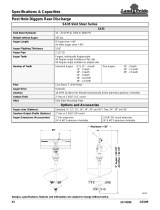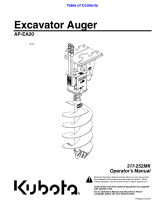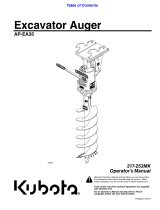
2
W 2005 by The Toro Company
8111 Lyndale Avenue South
Bloomington, MN 55420-1196
Contact us at www.Toro.com
All Rights Reserved
Printed in the USA
Contents
Page
Introduction 2. . . . . . . . . . . . . . . . . . . . . . . . . . . . . . . . .
Safety 2. . . . . . . . . . . . . . . . . . . . . . . . . . . . . . . . . . . . . .
Safety and Instruction Decals 3. . . . . . . . . . . . . . . . .
Specifications 3. . . . . . . . . . . . . . . . . . . . . . . . . . . . . . . .
Stability Ratings 4. . . . . . . . . . . . . . . . . . . . . . . . . . .
Setup 4. . . . . . . . . . . . . . . . . . . . . . . . . . . . . . . . . . . . . .
Loose/Separate/Optional Parts 5. . . . . . . . . . . . . . . .
Installing an Auger onto the Drive Head 5. . . . . . . .
Removing an Auger/Extension from the Drive
Head 6. . . . . . . . . . . . . . . . . . . . . . . . . . . . . . . . . .
Operation 6. . . . . . . . . . . . . . . . . . . . . . . . . . . . . . . . . . .
Digging a Hole 6. . . . . . . . . . . . . . . . . . . . . . . . . . . .
Maintenance 7. . . . . . . . . . . . . . . . . . . . . . . . . . . . . . . . .
Recommended Maintenance Schedule 7. . . . . . . . .
Greasing the Cradle Arm Pivot Points 7. . . . . . . . . .
Checking Planetary Gear Case Oil 7. . . . . . . . . . . . .
Changing Planetary Gear Case Oil 8. . . . . . . . . . . .
Storage 8. . . . . . . . . . . . . . . . . . . . . . . . . . . . . . . . . .
Troubleshooting 8. . . . . . . . . . . . . . . . . . . . . . . . . . . . . .
Introduction
Read this manual carefully to learn how to operate and
maintain your product properly. The information in this
manual can help you and others avoid injury and product
damage. Although Toro designs and produces safe
products, you are responsible for operating the product
properly and safely.
Whenever you need service, genuine Toro parts, or
additional information, contact an Authorized Service
Dealer or Toro Customer Service and have the model and
serial numbers of your product ready. You will find the
model and serial number on a plate located on the auger
drive head. On augers and extensions, the model and serial
number plate is located on the upper portion of the shaft.
Write the product model and serial numbers in the space
below:
Model No.
Serial No.
This manual identifies potential hazards and has special
safety messages that help you and others avoid personal
injury and even death. Danger, Warning, and Caution are
signal words used to identify the level of hazard. However,
regardless of the hazard, be extremely careful.
Danger signals an extreme hazard that will cause serious
injury or death if you do not follow the recommended
precautions.
Warning signals a hazard that may cause serious injury or
death if you do not follow the recommended precautions.
Caution signals a hazard that may cause minor or moderate
injury if you do not follow the recommended precautions.
This manual uses two other words to highlight information.
Important calls attention to special mechanical
information and Note: emphasizes general information
worthy of special attention.
Safety
Improper use or maintenance by the operator or owner
can result in injury. To reduce the potential for injury,
comply with these safety instructions and those in the
traction unit operator’s manual. Always pay attention
to the safety alert
symbol, which means CAUTION,
WARNING, or DANGER—“personal safety
instruction.” Failure to comply with the instruction may
result in personal injury or death.
Danger
Contact with a moving auger can cause
entanglement, severe wounds, and/or death.
Keep all others at least 10 feet away from the
auger during operation. Also, do not replace the
supplied bolt which secures the auger to the drive
head with a longer bolt as this may increase the
chance for entanglement.
Danger
If there are buried power, gas, or telephone lines in
the work area, you may dig into them causing
shock or explosion.
Have the property or work area marked for buried
lines and do not dig in marked areas.
When the engine is off, attachments in the raised
position can gradually lower, possibly pinning or
injuring someone.
Always lower the attachment lift each time you
shut off the traction unit.
Warning














